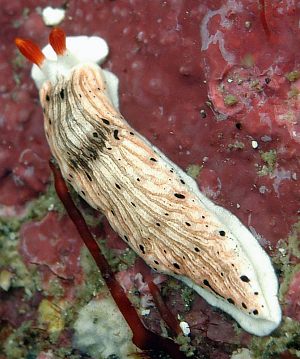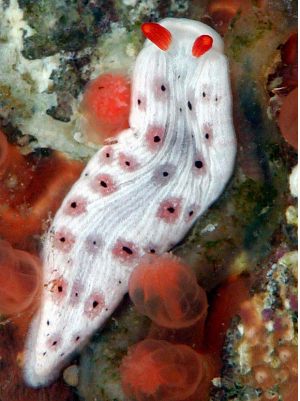

Dermatobranchus otome
Baba, 1992
Order: NUDIBRANCHIA
Suborder: ARMININA
Family: Arminidae
PHOTO
Upper: Futou, Suruga-bay, Japan, 15 Jun 2002, Size approx: 20mm, Depth: 5m. Photo: Kahoru Imamoto
Lower: Manazuru, Sagami-bay, Japan, 8 Dec 2002, Size approx: 10mm, Depth: 0.3m (Intertidal). Photo: Jun Imamoto.
Previously identified in Japan as Dermatobranchus striatus Van Hasselt, 1824. The body and foot are translucent white, and in adults the mantle has a brownish tinge. There are a series of longitudinal ridges which bear scattered black spots, each black spot being ringed by a brownish ocelli. About a third of the way down the mantle is a trnsverse, curved blackish band. The head shield is white and the rhinophotr clubs are bright orange-red, fading to a whitish tip. In juveniles, the brownish background colour is often absent on the mantle, and the ocelli surrounding each black spot, is proportionally larger, and translucent with a pinkish tinge, rather than brown.
Reference:
• Baba, K. (1937) Opisthobranchia of Japan (II). J. Dept. Agric. Kyusyu Imp. Univ. 5(7): 289-344. (Pls.1-2) [as D. striatus]
• Baba, K. (1949) Opisthobranchia of Sagami Bay collected by His Majesty The Emperor of Japan. Iwanami Shoten, Tokyo. 194pp., 50 Pls. [as D. striatus]
• Baba, K. (1976) Two new species and five common or rare species of the genus Dermatobranchus from Japan (Nudibranchia: Arminoidea: Arminidae). The Veliger, 19(1): 4-12. [as D. striatus]
• Baba, K. (1992) Critical review of Dermatobranchus striatus van Hasselt 1824 (Nudibranchia: Arminidae) with the description of a new species. Venus, The Japanese Journal of Malacology, 50(4): 239-248, 1pl.
• Baba, K., Hamatani, I. & Hisai, K. (1956) Observations on the spawning habits of some of the Japanese Opisthobranchia. 2. Publications of the Seto Marine Biological Laboratory 5(2): 209-220. (Pls.24-26) [as D. striatus]
Rudman, W.B., 2003 (January 14) Dermatobranchus otome Baba, 1992. [In] Sea Slug Forum. Australian Museum, Sydney. Available from http://www.seaslugforum.net/factsheet/dermotom
